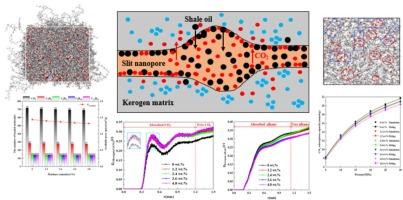CO2和页岩油在有机物纳米孔中吸附竞争的分子研究:考虑水分含量和组分的影响
IF 5.2
2区 化学
Q2 CHEMISTRY, PHYSICAL
引用次数: 0
摘要
页岩油与CO2在干酪根中的竞争吸附对提高CO2采收率和封存CO2具有重要意义。然而,在水合干酪根的狭缝纳米孔中竞争吸附的机理仍需进一步研究。本研究构建了水合干酪根的裂隙纳米孔竞争吸附模型,采用分子动力学(MD)方法研究了H2O在干酪根基质中的分布特征,采用大正则蒙特卡罗(GCMC)方法研究了单组分CO2的吸附行为。应用平衡分子动力学(EMD)方法分析了不同含水率条件下,CO2和页岩油在干酪根裂隙纳米孔中的竞争吸附特性,揭示了H2O对CO2和页岩油竞争吸附的影响机理。结果表明:对于单组分CO2,吸附量随含水率的增加而降低;对于多组分混合物,随着含水率的增加,CO2吸附量先减小后增大,页岩油的吸附量逐渐减小。CO2对干酪根的亲和力强于对页岩油分子的亲和力,提高了CO2替代页岩油的能力,促进了CO2的储存。长链烷烃在页岩油中较难被置换,短链烷烃对CO2的竞争吸附更为显著。利用原位水或注入一定量的水蒸气可增强CO2的竞争吸附能力。该研究为页岩油层绿色开发提供了理论和实践依据。本文章由计算机程序翻译,如有差异,请以英文原文为准。

Molecular insights into the competition of CO2 and shale oil adsorption in organic matter slit nanopores: Considering the effects of moisture contents and components
The competitive adsorption between shale oil and CO2 in kerogen is of great significance for CO2 enhanced oil recovery (CO2-EOR) and CO2 storage. However, the mechanism of competitive adsorption in the slit nanopores of hydrated kerogen still needs to be clarified. This study constructed a slit nanopores competitive adsorption model for hydrated kerogen, used molecular dynamics (MD) methods to investigate the distribution characteristics of H2O in kerogen matrix, employed grand canonical Monte Carlo (GCMC) methods to study the adsorption behavior of single-component CO2, and applied equilibrium molecular dynamics (EMD) methods to analyze the competitive adsorption characteristics of CO2 and shale oil in slit nanopores of kerogen under different moisture contents, revealing the mechanism of the influence of H2O on the competitive adsorption of CO2 and shale oil. The results show that for single-component CO2, the adsorption capacity decreased with the increase in moisture content. For multi-component mixtures, the CO2 adsorption capacity decreased first and then increased with the increase in moisture content, while the adsorption capacity of shale oil gradually decreased. The affinity of CO2 for kerogen was stronger than that of shale oil molecules, and the ability of CO2 to replace shale oil was improved, which promoted CO2 storage. Long chain alkanes in shale oil were more difficult to be displaced, and the competitive adsorption of short chain alkanes with CO2 was more significant. Using in-situ water or injecting a certain amount of water vapor can enhance the competitive adsorption capacity of CO2. This study provides theoretical and practical basis for the green development of shale oil reservoirs.
求助全文
通过发布文献求助,成功后即可免费获取论文全文。
去求助
来源期刊

Journal of Molecular Liquids
化学-物理:原子、分子和化学物理
CiteScore
10.30
自引率
16.70%
发文量
2597
审稿时长
78 days
期刊介绍:
The journal includes papers in the following areas:
– Simple organic liquids and mixtures
– Ionic liquids
– Surfactant solutions (including micelles and vesicles) and liquid interfaces
– Colloidal solutions and nanoparticles
– Thermotropic and lyotropic liquid crystals
– Ferrofluids
– Water, aqueous solutions and other hydrogen-bonded liquids
– Lubricants, polymer solutions and melts
– Molten metals and salts
– Phase transitions and critical phenomena in liquids and confined fluids
– Self assembly in complex liquids.– Biomolecules in solution
The emphasis is on the molecular (or microscopic) understanding of particular liquids or liquid systems, especially concerning structure, dynamics and intermolecular forces. The experimental techniques used may include:
– Conventional spectroscopy (mid-IR and far-IR, Raman, NMR, etc.)
– Non-linear optics and time resolved spectroscopy (psec, fsec, asec, ISRS, etc.)
– Light scattering (Rayleigh, Brillouin, PCS, etc.)
– Dielectric relaxation
– X-ray and neutron scattering and diffraction.
Experimental studies, computer simulations (MD or MC) and analytical theory will be considered for publication; papers just reporting experimental results that do not contribute to the understanding of the fundamentals of molecular and ionic liquids will not be accepted. Only papers of a non-routine nature and advancing the field will be considered for publication.
 求助内容:
求助内容: 应助结果提醒方式:
应助结果提醒方式:


